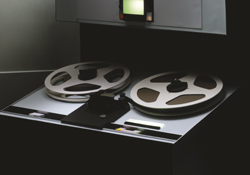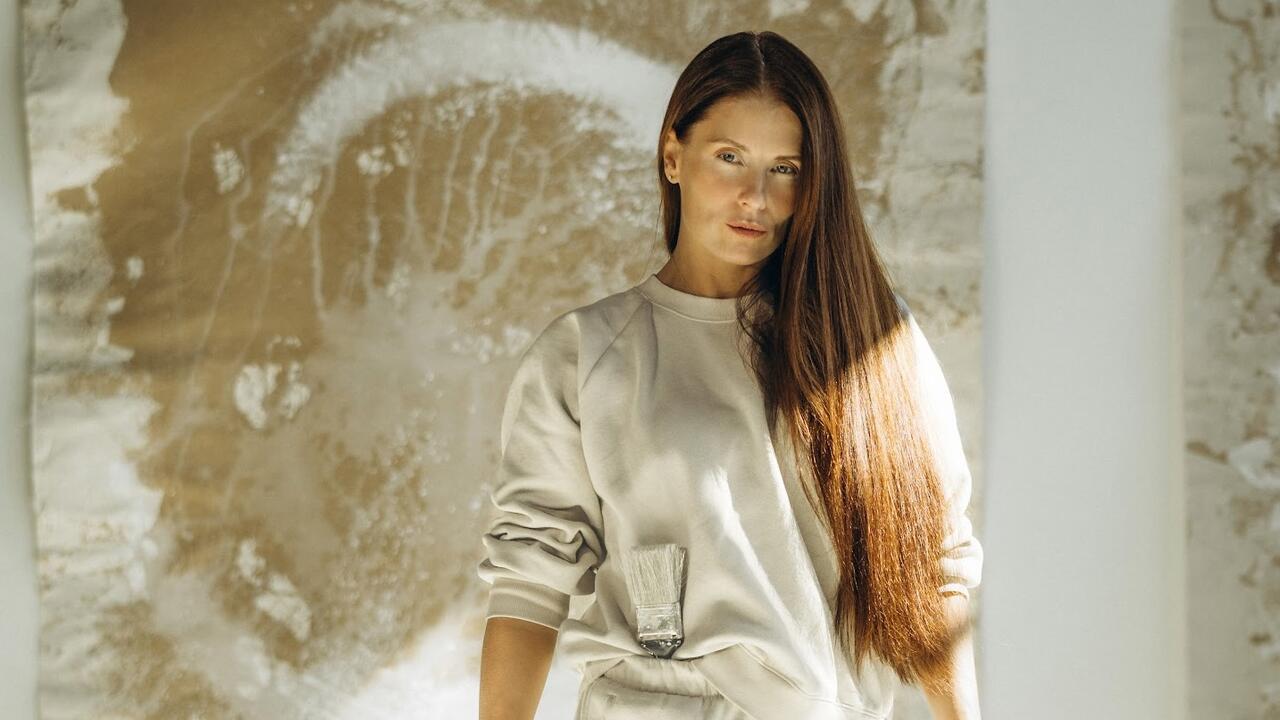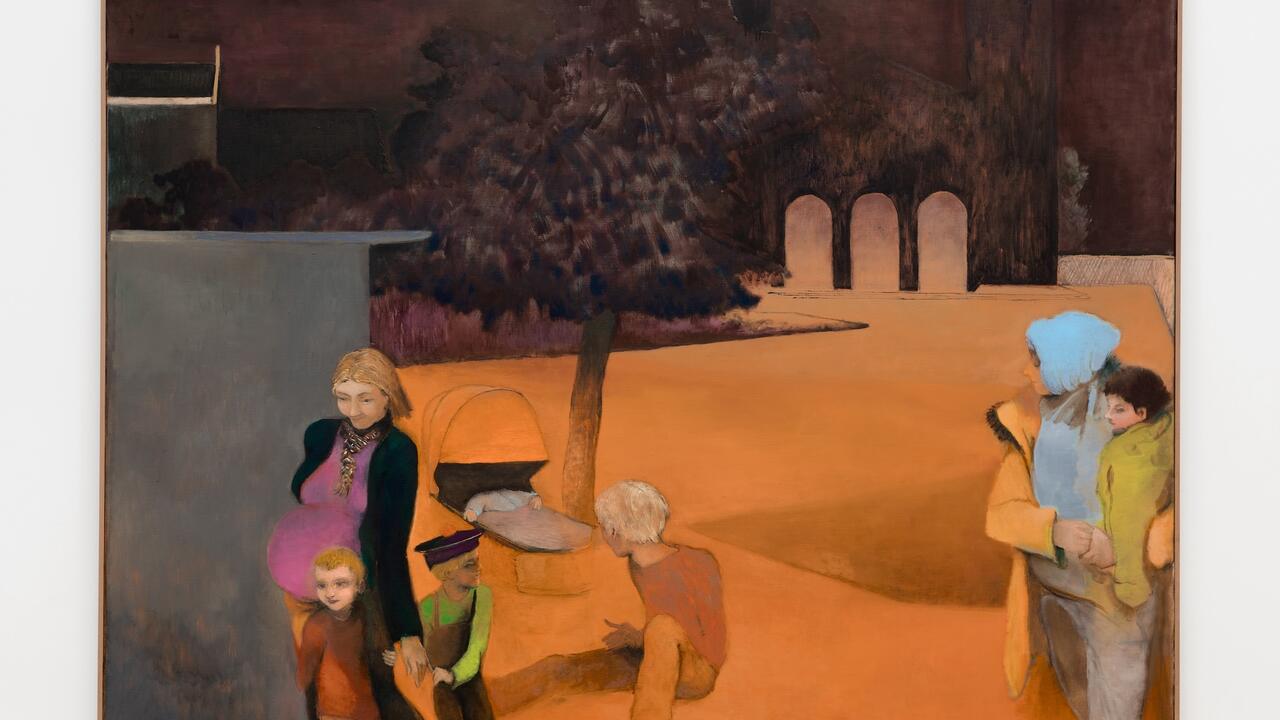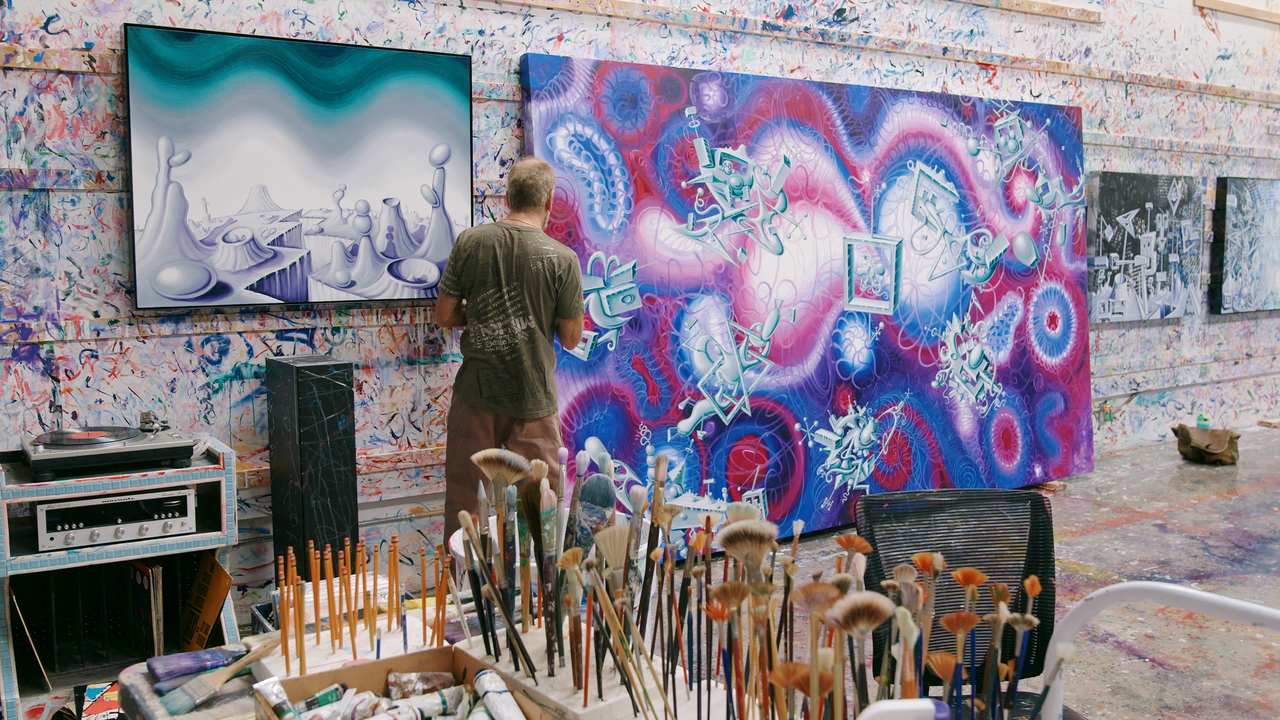Pulp Fiction
Thomas Demand
Thomas Demand

In the summer of 1966 Brian Wilson started recording sessions for the next Beach Boys album. What he envisioned was a complex Pop masterpiece that would make the Beatles jealous, but it was never released. Some of the fragmented recordings surfaced on later releases, some on bootlegs, but Smile as a whole has remained Pop history's great lost album. Fans still argue about what went wrong.
One theory is that the project nose-dived on 28 November 1966. Wilson had conceived a musical suite based on the four elements. Musicians gathered that day to record a musical interpretation of 'fire', with strings like licking flames and percussion crackling like burning wood. Legend has it that in the ensuing days, as if there was some sort of jinx on the recording, a rash of fires broke out across Los Angeles. Wilson - who at the time was taking LSD and smoking a lot of pot - was so freaked out that he allegedly destroyed the recording (actually he only shelved it).
Thomas Demand's 35-mm film loop Recorder (2002) may not start any fires, but it didn't leave me cold either. Before I entered the space where it was projected in the extensive exhibition of his work at Munich's Lenbachhaus, I could already hear a cyclical, dreamy but stuttering piano tune. What I eventually saw on the small cinema screen was a static shot of a studio tape recorder running. A green control light is on, the reels are turning; the left one, with less tape remaining, is perceptibly faster than the right. Yet the movement has the characteristic quirkiness of stop-motion animation. A closer look confirms that this is in fact the case: the machine, down to the minutest detail, is - like everything on Demand's planet - accurately yet undeniably made of paper. A series of large-format photographs of the object, with the reels' position altered progressively in each shot, were transferred to 35-mm film at 24 frames per second, creating a single, endless loop. But knowing how it was made didn't stop me from being transfixed by the piece.
One reason for this may be that most of Demand's photographs, and all four film pieces he has made over the last few years, are based on existing images of real incidents. In his large Berlin studio Demand sets up his plate camera, builds a precise life-size paper replica of an environment, sets the lights, checks the angles and the technical details over and over through the viewfinder and finally clicks the shutter; then he throws the often immensely huge but delicate construction away to make room for the next one. The only way for him to have the confidence to go through this irreversible process is by knowing his subject down to the last detail. Even the most ordinary objects have a very particular 'look', so the first step is a process of intensive research. Demand came across a promotional clip shot by Capitol Records to advertise the postponed release of The Beach Boys' Smile album, which included footage of the tape machine used for the recording sessions. Just as close-ups of tape spools slowly turning are a cinematic convention - articulating a kidnapper's ransom demand or showing spies tapping a conversation - so Beach Boys fans were supposed to feel as though they were eavesdropping on the creation of a masterpiece.
But even the most devoted fan could be forgiven for not identifying the music in Demand's piece as a variation on 'Bicycle Rider', an instrumental from the Smile sessions. The harpsichord theme of the original is reminiscent of a musical clock, or - with the title in mind - the spokes of a wheel revolving and glinting in the sun. Recorder throws these imaginative wheels back on to the physical reels used in its creation. The artistic process stares at itself in horror: the sound is muffled and bathed in reverb, the melody chopped and reassembled, as if it were the soundtrack to the scene of a deranged psychopath locked in a childhood fantasy world. And to a certain degree that was what Wilson was during the Smile recordings - drugged and at odds with his brothers and the record company. Recorder captures the trauma of perfection drowned in a morass of dependencies: paper reels perpetually turning.
What is it about Demand's piece that is so arresting? Like a baby nodding off to a lullaby, my judgement is easily swayed by a mellifluous sound. Would I have liked the piece if it hadn't been based on a Beach Boys tune? The problem with art that makes grand references is that often it borrows the weight and aura of the original without acknowledging it: like driving your dad's Mercedes to impress a date. The connoisseurship required by the allusion obscures the artist's particular aesthetic approach. (Sometimes there simply is no aesthetic content to be obscured - as, for example, in many recent figurative paintings that try to come across as Warhols or Richters of the electronic era.)
Fully aware of this problem, Demand is almost too suspicious that his audience will thankfully latch on to the story rather than the way it's told. To avoid this the reference is never spelt out in the image itself, or in the purely descriptive titles, and there is never an explanatory text on the wall beside the work. Tunnel (1999), one of the three films projected at the Lenbachhaus, is a tracking shot from a driver's perspective through an empty tunnel lined by concrete pillars. The movement is accompanied by an ominous whirling noise, as if a huge cannon ball rather than a car were moving through the tunnel. Hof/Yard (2001) is a slow night-time pan across a fenced-in, hedged backyard; the naked façade of a single-storey building is illuminated by flashlights, suggesting photographers trying to get a snapshot of an invisible man moving from left to right. The only audible sounds are the clicks and motors of cameras, and the distant hum of traffic. Demand avoids the all too obvious, iconic image. And he avoids the heat of the moment: it is possible that some would still, five years or so after the fact, recognize that Tunnel is modelled on the Paris underpass where Princess Diana died, but you would probably have to be one of the paparazzi present at Slobodan Milosevic's arrival in The Hague to recognize the former Yugoslav leader's prison. If Demand told rather than just showed, we could be fooled into believing that ordinary modern environments hold singular truths beyond their obvious, banal function - that they mean something without the presence of lights, camera, action. His reconstruction points out meaning just as much as the lack of it.
Even the most important media stories rarely survive longer than three months in the face of the public's desire to forget and move on. The only time Demand tapped into this limited memory span was in a gallery show at 303, New York, early in 2001. Just weeks after George W. Bush's inauguration, the infamous and controversial Florida 'manual recount' of late 2000 was still fresh in visitors' minds when they were confronted with a rendition of the office where it took place (Poll, 2001) and a series of close-ups of stacks of blank ballot papers Stapel 1-5/Pile 1-5 (2001). As with all of Demand's dioramic views, any sign of use, any 'flaw' in the original objects, is purged, replaced by the new 'flaw' of being paper-made, clearly recognizable in the clarity of a pristine print. Hence the absurdity of trying to verify the Florida vote by closely examining piles of voting slips was literally laid bare: this time Demand's paper trick was about a paper trick. The cold, almost cruelly clinical nature of the artist's transformation routine was duplicated and suddenly took on the deadpan humour of good Agit-prop. But displayed at the Lenbachhaus almost two years later that effect has faded, and rightly so: like the incident, its image has receded into obscurity - the fierce laughter it once produced has frozen into a puzzled grimace, even for those who still remember.
Demand divorces fact from fabrication, but although he never fingers his sources he allows rumours of their identities to escape. People usually find out what his pieces refer to by talking to gallery owners, curators and critics, who in turn ask the artist. A lucky guess might identify Gangway (2001) as being used by a once travel-mad Pope; but it's like being told an unsavoury rumour when you hear that behind one of the doors of the ostensibly ordinary Flur/Corridor (1995) is where Jeffrey Dahmer kept the bodies of his victims. And, as happens with rumours, they can get distorted. It has been claimed, for example, that Rolltreppe/Escalator (2001) - the animated film of a moving escalator - was based on the James Bulger case, in which two ten-year-old boys killed a toddler in Liverpool. In fact it refers to an escalator near Charing Cross Bridge in London where a gang was caught on surveillance camera shortly after they had robbed two men and thrown them into the Thames, killing one of them.
Encountering Demand's work in the mid-1990s, I had reservations about the painstaking labour that went into - I thought - making me adopt the silly role of a gumshoe investigating a trompe l'oeil. It took a while for me to understand, while Demand's catalogue grew and became more complex, that my reservations were beside the point. It was not just about illusionist, theatrical effect. Demand's sculptural labour of creating a copy disembodies and displaces the 'labour' that has gone into building and inhabiting the original environments. So the confusion over what is the story 'behind' the scene is a welcome part of the work's reception: it produces gaps through which we can glimpse, with surprised eyes, the stripped-down designs of the modern world.
In 1968 Ellsworth Kelly looked down at the ground and picked up a crushed green paper cup. He made a drawing from it, reducing the flattened form to a geometric curve. Twenty-nine years later he based one of his large shaped canvases, Green Curves (1997), on it. In the Beyeler Foundation in Basel the paper cup and the canvas were recently exhibited side by side in a small, dimly lit room. Standing there, eyes moving back and forth between the old, dirty, discarded cup and the immaculate monochrome canvas, you could not but feel like an archaeologist from the future who has entered a burial chamber of the 20th century and found a relic next to its own abstraction. Demand's oeuvre feels like the result of that archaeologist trying to work out what happened in the empty space between the two finds, trying to freeze-frame the very moment of transformation from fetish to form.
But there is not just a single moment: a complex and elastic system of images has unfolded over the years, spanning the distance from depth to surface, the determinate to the indeterminate, the painstakingly detailed to the oddly simple. It's a parallel world, complete with starry skies (Konstellation/Constellation, 2000) and ever shifting sunbeams coming romantically through the foliage (Flare, 2002). You may feel like Kyle McLachlan in David Lynch's Blue Velvet (1986) when you look at the evenly cut grass of Rasen/Lawn (1998), just about to discover a severed ear (even though there is none) among its thousands of paper-made leaves. Or you might feel like hitting your head against a glass door while looking at Paneel/Peg Board (1996): there is nothing 'hidden' in the photograph of a wall panel evenly punched with holes, except that it's handmade. In the Munich exhibition these pieces acted as yardsticks of meaning by which you could measure the more history-laden works (painters know this trick, often hanging at least one 'odd' choice to heighten the dynamics).
This will to create a pictorial system that expands and reorganizes itself constantly like a living population is something Demand shares with Thomas Ruff or Andreas Gursky. In this regard - and in terms of technical perfection - all of them join Gerhard Richter's painterly filter of the visual with Bernd and Hilla Becher's stoic photo-inventory of the Industrial Age. Demand studied in Dusseldorf, though not with Richter or the Bechers but with the sculptor Fritz Schwegler. And it's certainly the sculptural element that sets him apart in this context.
The physical treatment of space explains the most obvious absence in his work: that of bodies. The closest Demand has ever come to depicting people were the cut-out silhouettes of politicians and heads of state depicted in the picture frames arranged on Sir Edward Heath's grand piano (Flügel/Grand Piano, 1993). Even the 'imprint' of human bodies is only faintly present in the crumpled linen on the day-bed in Salon/Parlour (1997) or on the pillow on L. Ron Hubbard's bed (Zimmer/Room, 1996). It would be misleading to ascribe the absence of the living to a desire to achieve a kind of haunted house effect, or simply to technical difficulties. Rather, this absence, ex negativo, indicates the way we inhabit built environments by relying on their resistance, their material weight. In her book The Body in Pain: The Making and Unmaking of the World (1985) Elaine Scarry describes how imagination evolves out of the human body's instability and vulnerability - how pain produces the need to design things, the chair for example, in order to avoid it, and is thus turned into the more acceptable form of labour. But in Demand's paper world everything would immediately crumble and fall to pieces once we tried to use and inhabit it. The fear of instability that once created built environments returns with a vengeance, indicated by the absence of humans.
Of course, there is one person who actually does inhabit these environments - Demand himself. When I visited his studio, he was working on a new piece based on a photograph from a 1950s tabloid of a room in which objects - plates, a book - hover in mid-air above a desk, as if moved by some poltergeist. Nothing was hovering yet in the studio, but just standing next to the finished, life-size desk already was a bit like being on drugs. The pun of recreating a scene of objects defying gravity, moved by invisible hands, brings Demand's work full circle. Maybe Brian Wilson really was responsible for those fires.
























